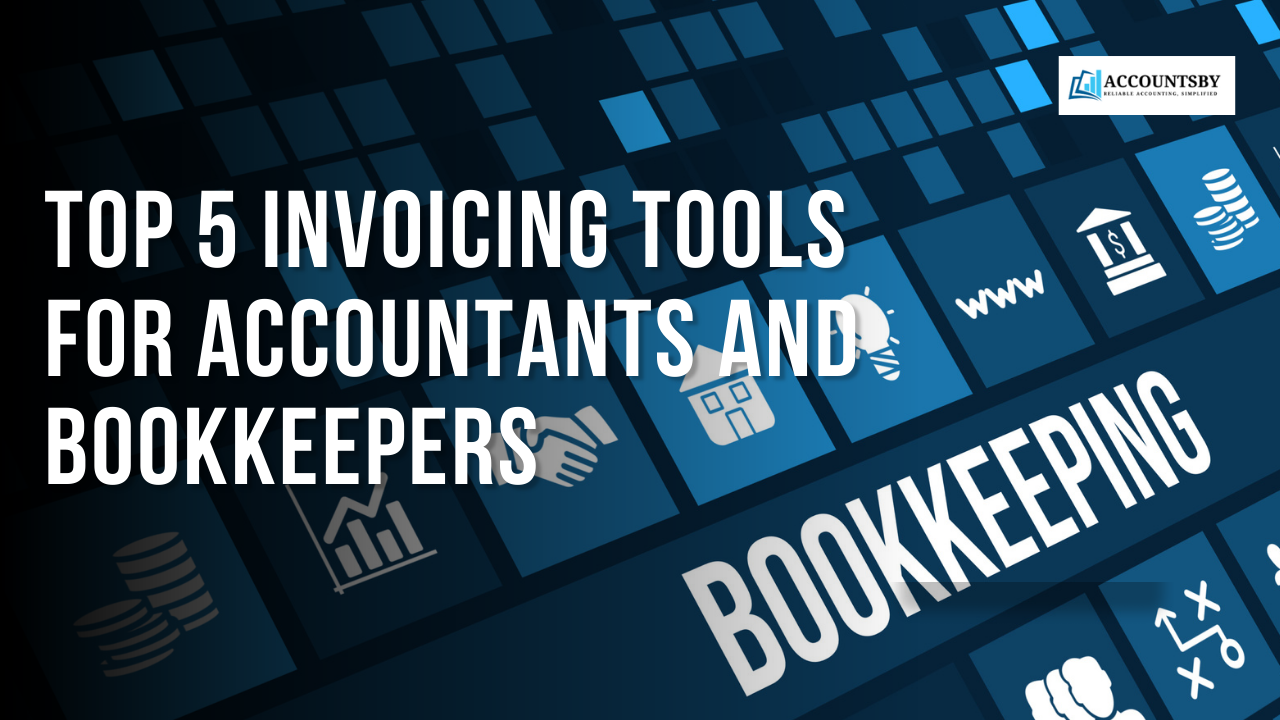As an accountant or bookkeeper, your time is invaluable. While you’re busy helping clients manage their finances, you also need efficient ways to manage your own. Sending accurate, professional invoices and ensuring timely payments are critical for your firm’s cash flow and profitability. Manual invoicing or using outdated systems can be a significant drain on your resources.
This article explores the top 5 invoicing tools designed to streamline the billing process for accountants and bookkeepers. We’ll examine their key features, discuss their pros and cons, and provide insights to help you choose the best solution for your practice.
Why Invoicing Tools Are Essential for Your Practice
Invoicing tools are far more than just a way to send bills. For accounting and bookkeeping professionals, they are crucial for:
- Improving Cash Flow: Automated reminders and online payment options significantly reduce payment delays.
- Saving Time: Automating invoice generation, sending, and tracking frees up valuable time you can dedicate to client work or business growth.
- Enhancing Professionalism: Customizable templates ensure your invoices reflect your firm’s professional image.
- Accurate Record-Keeping: Integrated systems ensure all billing data is captured correctly, simplifying reconciliation and tax preparation for your own business.
- Better Client Experience: Easy-to-understand invoices and convenient payment options improve client satisfaction.
Let’s dive into the top 5 invoicing tools that can transform your billing process.
Also Read: The Ultimate Bookkeeping Checklist for New Business Owners
The Top 5 Invoicing Tools for Accountants and Bookkeepers
1. QuickBooks Online
QuickBooks Online (QBO) is an industry-leading accounting software that includes a robust invoicing module, making it a natural fit for accountants and bookkeepers who may already use it for client work.
Pros:
- Comprehensive Integration: Seamlessly integrates invoicing with full accounting features (expense tracking, bank reconciliation, reporting) for your own firm.
- Professional Templates: Offers a variety of customizable invoice templates.
- Automated Features: Supports recurring invoices, automatic payment reminders, and online payment acceptance (via QuickBooks Payments).
- Client Management: Manage client details, payment history, and outstanding balances all in one place.
- Mobile App: Create and send invoices on the go.
Cons:
- Subscription Cost: Not a free tool; requires a paid subscription, which can be a consideration for smaller practices.
- Feature Overload for Basic Needs: Might have more features than necessary if you only need invoicing.
- Learning Curve: Can have a learning curve if you’re new to the QuickBooks ecosystem.
Did You Know?
QuickBooks Online offers a special “Accountant” version that provides tools and dashboards specifically designed for accounting professionals managing multiple client accounts.
2. Zoho Invoice
Zoho Invoice is a dedicated invoicing solution from the broader Zoho suite, offering a feature-rich free plan alongside powerful paid options, making it versatile for practices of all sizes.
Pros:
- Robust Free Plan: Offers unlimited invoices, estimates, client management, and expense tracking (though free plan limits apply in some regions, like India where it’s generally free for businesses under INR 50,000 annual revenue).
- Customizable Templates: Extensive options to brand your invoices.
- Client Portal: Provides a dedicated portal where clients can view invoices, statements, and make payments.
- Automated Reminders: Helps follow up on overdue payments automatically.
- Multi-Currency Support: Ideal for firms with international clients.
Cons:
- Feature Limitations in Free Plan: While strong, the free plan might have limitations that require an upgrade as your practice grows.
- Standalone Product: While part of Zoho ecosystem, it’s not a full accounting solution by itself like QBO (though it integrates with Zoho Books).
- Initial Setup: Like any comprehensive tool, it requires some initial setup for branding and client details.
3. FreshBooks
FreshBooks is popular among service-based businesses, including accountants and bookkeepers, known for its user-friendly interface and strong invoicing capabilities.
Pros:
- Intuitive Interface: Extremely easy to use, even for those without extensive accounting software experience.
- Excellent Invoicing: Strong features for creating, sending, and tracking professional invoices, including recurring options and payment reminders.
- Time Tracking: Built-in time tracking, which is invaluable for service-based professionals who bill by the hour.
- Expense Tracking & Reporting: Good for managing your own practice’s expenses and generating basic reports.
- Integrated Online Payments: Makes it easy for clients to pay invoices directly.
Cons:
- Pricing Tiers Based on Active Clients: Subscription costs can increase significantly as you add more active clients.
- Not a Full Double-Entry Accounting System: While it handles essential functions, it’s more focused on invoicing and project management than full-fledged double-entry accounting.
- Limited Integrations (Compared to QBO): While it integrates with many tools, its ecosystem might be smaller than QuickBooks.
4. Wave Accounting
Wave is an excellent option for accountants and bookkeepers, especially those starting out or with smaller practices, due to its comprehensive free accounting suite that includes invoicing.
Pros:
- Completely Free Accounting Software: Offers unlimited invoicing, expense tracking, bank reconciliation, and financial reporting (P&L, Balance Sheet) without a subscription fee.
- Professional Invoicing: Create and send professional invoices with customization options.
- Automated Bank Feeds: Connects to bank accounts to automatically import transactions for easy reconciliation.
- User-Friendly: Designed for ease of use, even for non-accountants.
Cons:
- Payroll is Paid: If you have employees, payroll processing is a paid add-on.
- Customer Support: Free users primarily rely on online help articles and community forums.
- No Accounts Payable (A/P) in Free Version: Cannot track money you owe to vendors/suppliers within the free module.
- Less Robust for Large Firms: May lack advanced features needed by larger accounting firms.
5. Harvest
Harvest focuses on time tracking and invoicing, making it a powerful tool for service-based professionals who bill clients based on hours worked.
Pros:
- Robust Time Tracking: Highly intuitive time tracking features, allowing you to track billable hours easily across projects and clients.
- Effortless Invoicing from Time Entries: Generate invoices directly from your tracked time and expenses with just a few clicks.
- Project Budgeting: Monitor project budgets and receive alerts when you’re nearing limits.
- Integrations: Connects with many popular tools like Asana, Trello, Slack, and QuickBooks Online.
- Simple Reporting: Provides clear reports on billable hours, project profitability, and client invoicing.
Cons:
- Paid Tool (Limited Free Trial): Not a free tool; requires a paid subscription after a trial period. Pricing tiers are based on the number of projects.
- Not a Full Accounting System: Primarily a time tracking and invoicing solution, not a comprehensive accounting platform like QBO or Wave.
- Steeper Price for Multiple Projects: Costs can add up if you manage many clients/projects simultaneously.
Comparison Table: Invoicing Tools for Accountants and Bookkeepers
| Tool | Primary Focus | Key Invoicing Features | Pros | Cons |
| QuickBooks Online | Full Accounting | Recurring invoices, Online payments, Customizable templates | Seamless integration with accounting, Professional, Mobile app | Paid subscription, Can be feature-heavy for basic needs |
| Zoho Invoice | Dedicated Invoicing | Unlimited invoices (free plan limits may apply), Client portal, Reminders | Strong free plan, Multi-currency, Client portal, Automated reminders | Free plan limits in some regions, Not full accounting alone |
| FreshBooks | Invoicing/Time Track | Time tracking, Recurring invoices, Automated reminders | User-friendly, Excellent invoicing, Built-in time tracking | Subscription cost tied to active clients, Not full accounting |
| Wave Accounting | Free Full Accounting | Unlimited invoices, Bank sync, Reports | Completely free accounting suite, Professional invoices, Easy to use | Basic support for free, Payroll is paid, No A/P in free version |
| Harvest | Time Tracking/Invoicing | Invoice from time/expenses, Project budgeting | Robust time tracking, Effortless invoicing from time, Integrations | Paid subscription, Not full accounting system, Price for many projects |
Conclusion
The right invoicing tool can significantly enhance the efficiency and profitability of your accounting or bookkeeping practice. Whether you need a full-fledged accounting suite with integrated invoicing like QuickBooks Online or Wave, a dedicated invoicing powerhouse like Zoho Invoice or FreshBooks with strong time tracking, or a specialized solution like Harvest, there’s a tool tailored for your needs.
Consider your practice’s size, your budget, the complexity of your billing, and your desire for integrated features when making your choice. Investing time in selecting the right invoicing tool now will save you countless hours and ensure smoother financial operations for your firm in the long run.
References & Further Reading:
- QuickBooks Online Accountants Official Site
- Zoho Invoice Official Site
- FreshBooks Official Site
- Wave Accounting Official Site
- Harvest Official Site



